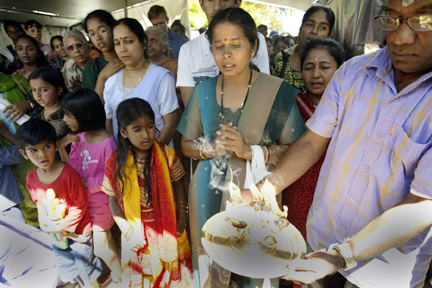
|
View from
the Pew |
Hindus honor stones
as image of Shiva
W orshippers chanted the 1,000 names of the Hindu god Shiva while priests honored his image by bathing it in milk and draping it with leis.About 100 Hawaii residents gathered Sunday for one of the major holy days in the Hindu religion. For many it brought memories of the Mahasivaratri observance in India and other countries where temples are filled with thousands of worshippers.
The place they worshipped was not a temple, but the small paved site of the "healing stones of Wahiawa," which is viewed as a sacred place by local Hindus.
The tallest of three boulders is of the pillarlike shape that traditionally depicts Shiva. A tarpaulin was raised and woven mats were laid for the worship service before the stones.
"We treat that place as a Shiva temple in our minds," said S. Ramanathan, a University of Hawaii pharmacology professor.
The stones have drawn visitors since the 1920s because of their purported healing power. Ramanathan and other Hindus were first drawn to the location in 1988 after reading about it in Hinduism Today.
"We recognized the god," he said. "We know he (the rock) is a Hawaiian god. Since he resembles Shiva, we worship him, too." Man-made versions of the "lingam," or pillar, are found in temples around the world, but finding it in nature is special, the professor said. "When the god has come on his own, it has special power. In India the stone would attract millions of people. We have a good feeling about it; everyone has a positive feeling when they are near him. We give energy to the god and get energy back."
An energetic ritual it was for Ramanathan and Dharm Bahwuk, a UH business professor. They took priestly roles in the two-hour service, or "pooja," bathing the stone, wiping handfuls of yogurt, clarified butter and honey on it, tossing grain at its feet. After they had wrapped the stone in cloth and draped it with leis and medallions, people came forward to touch it and pray, bowing with folded hands.
There is symbolism dating back more than 2,000 years in the rituals, Ramanathan said. As in other religions, the symbols are guides for developing their spiritual life.
» Coconuts are cracked and the water is poured on the image, symbolizing "breaking your ego."
» A lamp is passed around the image, and people seek to breathe the smoke. The camphor fuel leaves no residue, a lesson to "leave nothing of yourself."

Gopi Gopalakrishnan of Hawaii Kai held sacred candles while dozens came to witness the cleansing of the healing stones on Sunday afternoon in Wahiawa.
"Going to a temple together is not a Hindu thing," said Raji Jetley. "We pray in our own house," and each home would likely have a small shrine.
Hawaii's diversity was reflected in the Hindu crowd, which included people from different parts of the world and from different divisions within the religion. The monthly worship "is a chance to get together with people and catch up," said Dr. Kuldip Bhogal, a Sikh, whose people would pray in a separate temple in India.
The Sunday crowd was double the usual monthly gathering. After the service, the group adjourned to a nearby park to celebrate Holi, an Indian folk festival. People celebrate the coming of spring by "throwing colors" at each other. In this context it was colored water, which youngsters gleefully dispensed from an arsenal of water guns.
The healing stones are cemented down and enclosed in a low concrete structure that is open on one side. The shed dates from before the Hindu discovery of the site. The Hindu group turned it into a shrine, covering it with white marble and paving the surrounding area with marble in 1996, a $60,000 investment by the Ashu Sawney family.
The Hindus recognize the two smaller healing stones as Nandhi, the bull that pulls Shiva's chariot, and Ganesha, the elephant-faced god. The lesser gods got a few leis but minimal attention in the Sunday festival devoted to Shiva.
Hinduism arose in India about 3,500 years ago and has evolved through writings and teachings of different sages into several branches. The faithful recognize a pantheon of gods. Shiva is one of a trio who account for the "cosmic cycle," Ramanathan said. Brahma is the creator, Vishnu is the protector and Shiva is the destroyer. "He is not evil, not a fearful god," the professor explained, but completes the cycle of life and death in the destiny of the universe.
Ramanathan said having the common gathering place sparked the creation of the Lord of the Universe Society, better known by its acronym LOTUS, a nonprofit organization that sponsors the monthly pooja and other cultural and spiritual activities.
There are at least 1,500 people in the Hindu community, many of whom are young adult professionals or university students, and a core group of about 60 families.
LOTUS has cultivated a good relationship with neighbors of the healing stones site, which is city property. It has an arrangement with the Methodist church next door to bring water to the shrine to flush away the butter, honey and milk. "People in the neighborhood say it is more peaceful since we started worshipping there," Ramanathan said.
LOTUS is engaged in a new effort at neighboring with a group of Hawaiians who recently began to tend the healing stones and favor opening the enclosure so sunlight and rain can reach them. The Hawaiians and Hindus have discussed mutual concerns about keeping the stones clean and free of graffiti. "We both have special feelings for the stone," Ramanathan said.
"All of our prayers are for the welfare of the universe and all living things," he said.
![]()
[News] [Business] [Features] [Sports] [Editorial] [Do It Electric!]
[Classified Ads] [Search] [Subscribe] [Info] [Letter to Editor]
[Feedback]
